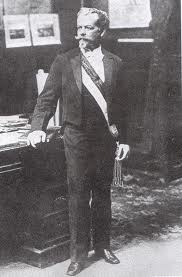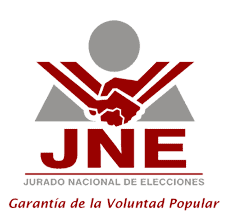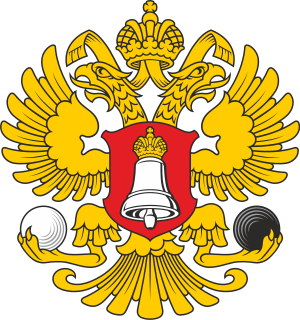
An election is a formal group decision-making process by which a population chooses an individual or multiple individuals to hold public office.

The president of Peru, formally recognized as the President of the Republic of Peru, is the head of state and head of government of Peru. The president is the head of the executive branch and is the Supreme Head of the Armed Forces and Police of Peru. The office of president corresponds to the highest magistracy in the country, making the president the highest ranking public official in Peru.
The Office of the Chief Electoral Officer, commonly known as Elections Canada, is the non-partisan agency responsible for administering Canadian federal elections and referendums. Elections Canada is an office of the Parliament of Canada, and reports directly to Parliament rather than to the Government of Canada.

In Peru, the people directly elect a head of state as well as a legislature. The president is elected by the people for a five-year term. The unicameral Congress (Congreso) has 130 members, also elected for a five-year term by proportional representation. Peru has a multi-party system, which effectively bars one party from becoming the sole influence in a decision-making process. As such, parties must work with one another to form coalition governments. The whole election process is held by the National Jury of Elections and the National Office of Electoral Processes. Peru has compulsory voting.

Jose Nicolás Baltasar Fernández de Piérola y Villena was a Peruvian politician and Minister of Finance who served as the 33rd and 39th President of the Republic of Peru, from 1879 to 1881 and 1895 to 1899.

General elections were held in Peru in on 9 April 2006 to elect the President, two Vice-Presidents, 120 members of Congress and five members of the Andean Parliament for the 2006–2011 period. As the no presidential candidate received a majority of the vote, a second round was held on 4 June between the top two candidates, Ollanta Humala and Alan García. Garcia won the run-off with 52.63% to Humala's 47.37%. He was subsequently inaugurated on 28 July 2006, Peruvian Independence Day.

The Instituto Nacional Electoral (INE) is an autonomous, public organization responsible for organizing federal elections in Mexico, that is, those related to the election of the President of the United Mexican States, the members of the Lower and Upper chambers that constitute the Congress of the Union as well as elections of authorities and representatives at local and state levels. The organization's president is Lorenzo Córdova Vianello, appointed in 2014 for a 9-year tenure.

General elections were held in Peru on 9 April 2000, with a run-off of the presidential election on 28 May. The elections were highly controversial and widely considered to have been fraudulent. Incumbent President Alberto Fujimori was re-elected for a third term with almost three-quarters of the vote. However, the elections were tainted with allegations of unconstitutionality, bribery, structural bias, and outright electoral fraud. Alejandro Toledo boycotted the second round of the presidential election, in which over 30% of ballots were declared invalid. Fujimori subsequently called for new elections, fled Peru, and faxed in his resignation from a hotel in Japan.

The National Jury of Elections of Peru is an autonomous constitutional organism, headquartered in Lima. Its goal is to oversee the legality of electoral processes, guaranteeing the respect for the population's will. Thus, it is the entity in charge of proclaiming the official electoral results and awarding recognitions or credentials to the elected authorities. Furthermore, it passes resolutions to regulate the electoral dispositions.

The National Registry of Identification and Civil Status is an autonomous constitutional body of the State of Peru. Its role is to maintain the records of births, marriages, divorces and deaths in the country, as well as of the suffrage eligibility and registration. Its headquarters are in downtown Lima.

The Central Election Commission of the Russian Federation ) is the superior power body responsible for conducting federal elections and overseeing local elections in the Russian Federation founded in September 1993. It consists of 15 members. The President of Russia, State Duma and Federation Council of Russia each appoint five members. In turn, these members elect the Chairman, Deputy Chairman and Secretary. The Commission is in power for a four-year term.

According to the Organic Law of Regional Governments, the regions are, with the departments, the first-level administrative subdivisions of Peru. Since its 1821 independence, Peru had been divided into departments but faced the problem of increasing centralization of political and economic power in its capital, Lima.

The Peruvian electoral system has as its mission the planning, organization and execution of elections in Peru, as well as keeping a civil registry. As defined by the Constitution it comprises the following institutions:

The Election Commission of Pakistan is an independent, autonomous, permanent and constitutionally established federal body responsible for organizing and conducting elections to the national parliament, provincial legislatures, local governments, and the office of President of Pakistan, as well as the delimitation of constituencies and preparation of electoral rolls. As per the principles outlined in the Constitution of Pakistan, the Commission makes such arrangements as needed to ensure that the election is conducted honestly, justly, fairly and in accordance with law, and that corrupt practices are guarded against. The Election Commission was formed on 23 March 1956 and has been restructured and reformed several times throughout the history of Pakistan.

The Socialist Party is a Peruvian political party founded in 2005. Its presidential candidate for the 2006 national election was Javier Diez Canseco. At the legislative elections held on 9 April 2006, the party won 1.2% of the popular vote but no seats in the Congress of the Republic.
The local government in Ukraine consists of two systems based on administrative divisions of Ukraine. There are 24 oblasts, the Autonomous Republic of Crimea, and two city councils with special status (regions), with each region further divided into amalgamated hromadas and raions (districts).

General elections were held in Peru on 10 April 2016 to determine the president, vice-presidents, composition of the Congress of the Republic of Peru and the Peruvian representatives of the Andean Parliament.
The Peruvian State, which is conceptually the Peruvian nation legally organized, is the entity that holds the government in the Republic of Peru. The state's structure is defined in the Constitution of Peru approved by referendum and promulgated in late 1993 and in force since January 1, 1994.

Municipal and regional elections were held in Peru on 7 October 2018. In the election, Peruvians voted for governors, vice governors and regional councilors at a regional level while at a municipal level, citizens voted for mayors and municipal councilors. Those elected took office 1 January 2019 and presumably serve their term until 31 December 2022.

Together for Peru is a major Peruvian left-wing political coalition of parties, political organizations, social movements and activist citizens whose main objective is to consolidate the different leftist and progressive sectors.
















